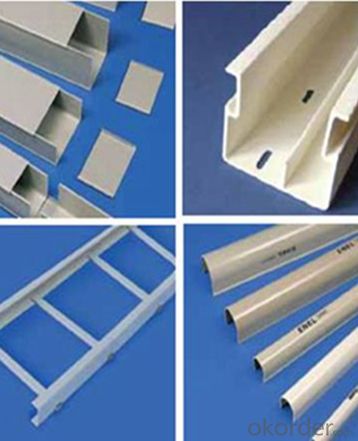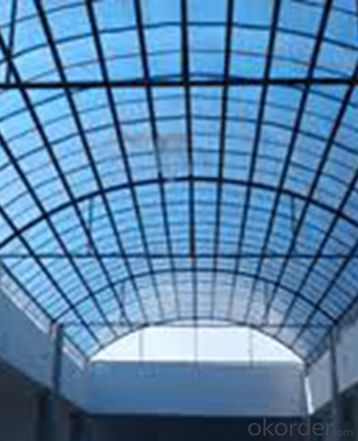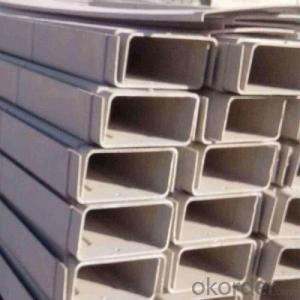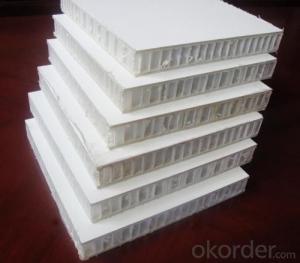FRP pultruded grating with Anti-flammable and good quality of different styles
- Loading Port:
- Tianjin
- Payment Terms:
- TT OR LC
- Min Order Qty:
- 1 m.t.
- Supply Capability:
- 100000 m.t./month
OKorder Service Pledge
OKorder Financial Service
You Might Also Like
PRODUCT DESCRIPTION
FRP pultruded grating has the most characteristics of molded grating, but it has its distinct advantages, it has very high fiberglass content in the loading direction, so it has very high load capability, it has more superiority when used at wide span, so that the basic support will be decreased and the project cost will be reduced accordingly.
SPECIFICATION
The standard space between two crossbars is 6 inch or 12 inch.
Thickness (mm) | Bar width (mm) | Open space (mm) | Open rate (%) | Approx weight (kg/m |
25.4 | 15.2 | 22.8 | 60 | 13.2 |
25.4 | 15.2 | 15.2 | 50 | 15.9 |
25.4 | 15.2 | 10.1 | 40 | 18.5 |
25.4 | 40 | 10.8 | 21 | 14.5 |
38.1 | 15.2 | 22.8 | 60 | 15.8 |
38.1 | 15.2 | 15.2 | 50 | 19.1 |
38.1 | 15.2 | 10.1 | 40 | 22.4 |
50.8 | 25.4 | 25.4 | 50 | 16.6 |
50.8 | 25.4 | 12.7 | 33 | 21.1 |
CHOICE FOR PULTRUDED GRATING
Resin: GP resin, ISO resin, VE resin, Phenol resin
Color choice: Yellow, gray, green, custom color
Surface choice: Groove surface, grit surface, lozenge cover surface
FEATURES
a. Anti-corrosion and anti-rust
b. Light weight and high strength
c. Anti-flammable
d. Anti- fatigue
e. Safe and anti-slippery
f. Anti-ageing
g. Easy of maintenance
h. Excellent electromagnetism property
i. Good economic benefit
FIELDS SERVED
Sewage treatment,
water supply and drainage,
chemical industry,
oil industry,
power engineering,
pulp and paper,
construction engineering,
spinning, marine engineering.
APPLICATION
Operation terrace,
stair walkway,
ground floor,
trench cover,
sidewalk,
foot bridge,
equipment safety fence,
scaffold.
COMPANT DESCRIPTION
CNBM,China National Building Materials Group is a state-owned enterprise in charge of administrative affairs in china building materials industry. Established in 1984, CNBM is a large group corporation of building materials with total assets of 25 billion RMB and a total staff of 30,000.CNBM now owns 200 subordinating firms of solely owned and joint-venture companies.
CNBM International Corporation is one subsidiary of CNBM, we focus on offering good-quality products,professional service and complete solution to our customers. Strong delivery capacity, advanced technology& management, strong financing capability and excellent after-sale service are our advantages in sharing international market.
FAQ
Q1.What's your sample policy?
A:We can supply the sample if we have ready parts in stock, but the customers have to pay the courier cost.
Q2.Can you produce according to the samples?
A: Yes, we can produce or modify the products according to your request.
Q3.How do you deliver the goods to my country?
A:We can provide international express, such as DHL, EMS, UPS, FedEx, etc. We select air freight and sea freight upon your requests. Quotations if without mentioning the shipping costs are shipping fee excluded.
Q4.How much does it cost to ship to my country?
A:When you goanna to place an order, please contact us, because different country has different freight.
Q5.How to get the catalogue?
A:please contact us and tell us what you are looking for.
We will try our best to meet customers' demands. Welcome you come here to visit us. We sincerely welcome partners around the world to establish business cooperation with us on the basis of mutual trust, benefit and development.
PICTURES



- Q:Can FRP pultrusion profiles be used in aerospace applications?
- Yes, FRP (Fiber Reinforced Plastic) pultrusion profiles can be used in aerospace applications. FRP materials have several advantages that make them suitable for aerospace use. Firstly, they have excellent strength-to-weight ratios, which is crucial in the aerospace industry to reduce weight and enhance fuel efficiency. Secondly, FRP materials exhibit high corrosion resistance, making them suitable for prolonged exposure to harsh environments, such as high altitude and extreme temperatures. Additionally, FRP pultrusion profiles offer design flexibility, allowing for complex shapes and geometries to be manufactured. This flexibility enables aerospace engineers to tailor the profiles to specific requirements and optimize performance. Furthermore, FRP materials have low thermal conductivity, which helps in insulation applications and reducing heat transfer. Lastly, FRP pultrusion profiles have demonstrated good fatigue resistance, which is essential for aerospace applications subjected to cyclic loading. Overall, these properties make FRP pultrusion profiles a viable choice for various aerospace components, including structural members, interior parts, and electrical enclosures.
- Q:Can FRP pultrusion profiles be used in telecommunications applications?
- Yes, FRP (Fiber Reinforced Polymer) pultrusion profiles can be used in telecommunications applications. FRP pultrusion profiles offer several advantages that make them suitable for telecommunications infrastructure. Firstly, FRP pultrusion profiles are lightweight yet strong, which makes them ideal for applications such as antenna supports, cable trays, and equipment racks. Their high strength-to-weight ratio allows for easier installation and transportation, while still providing the necessary structural support. Secondly, FRP pultrusion profiles are corrosion resistant, which is a crucial characteristic in telecommunication applications. Telecommunications infrastructure is often exposed to harsh environments, including moisture, chemicals, and extreme temperatures. Unlike traditional materials like steel or wood, FRP does not corrode or degrade in these conditions, ensuring long-term durability and reliability. Additionally, FRP pultrusion profiles offer electrical insulation properties, which is vital in telecommunications applications. They do not conduct electricity, making them safe for use in areas where electrical equipment is installed. This feature helps prevent electrical interference and ensures the integrity of the telecommunication system. Furthermore, FRP pultrusion profiles can be customized to meet specific design requirements. They can be manufactured in various shapes and sizes, allowing for flexibility in designing telecommunication infrastructure. This versatility makes FRP pultrusion profiles suitable for a wide range of applications within the telecommunications industry. In conclusion, FRP pultrusion profiles are well-suited for telecommunications applications due to their lightweight yet strong nature, corrosion resistance, electrical insulation properties, and customization possibilities. These attributes make them a reliable choice for supporting and protecting telecommunication infrastructure.
- Q:Are FRP pultrusion profiles resistant to alkalis?
- Yes, FRP pultrusion profiles are generally resistant to alkalis.
- Q:Can FRP pultrusion profiles be used in chemical processing plants?
- Yes, FRP (Fiber Reinforced Plastic) pultrusion profiles can be used in chemical processing plants. FRP pultrusion profiles offer excellent corrosion resistance, making them suitable for chemical environments where exposure to different chemicals, acids, and bases is common. Additionally, FRP pultrusion profiles are lightweight, yet strong, and can be fabricated to meet specific design requirements, making them versatile for various applications within a chemical processing plant. They are also electrically non-conductive, which is beneficial in environments where electrical insulation is necessary. Overall, FRP pultrusion profiles provide a durable and cost-effective solution for chemical processing plants, offering long-term performance and reducing maintenance costs.
- Q:Are FRP pultrusion profiles resistant to high winds or hurricanes?
- Yes, FRP (Fiber Reinforced Polymer) pultrusion profiles are highly resistant to high winds and hurricanes. FRP is a composite material that combines the strength of fiberglass with the durability of polymers. This results in a lightweight yet incredibly strong material that can withstand extreme weather conditions. FRP pultrusion profiles have been extensively tested and have proven to have excellent wind resistance properties. They have a high stiffness-to-weight ratio, allowing them to withstand the forces exerted by high winds without bending or breaking. Additionally, the inherent flexibility of FRP allows it to absorb and distribute the forces exerted by wind, reducing the risk of damage. In the case of hurricanes, FRP pultrusion profiles have demonstrated their ability to withstand the strong winds and flying debris associated with these severe weather events. They have been used in various applications such as building facades, bridges, and utility poles in hurricane-prone areas, with great success. Furthermore, FRP pultrusion profiles are corrosion-resistant, which is another advantage when it comes to withstanding high winds and hurricanes. Unlike traditional materials like steel or wood, FRP profiles do not rust or rot when exposed to moisture, making them even more suitable for these challenging weather conditions. Overall, due to their high strength, durability, flexibility, and corrosion resistance, FRP pultrusion profiles are an excellent choice for applications where resistance to high winds or hurricanes is required.
- Q:Are FRP pultrusion profiles resistant to oil or fuel spills?
- Yes, FRP (Fiber Reinforced Polymer) pultrusion profiles are generally resistant to oil or fuel spills. FRP is known for its excellent resistance to a wide range of chemicals, including oils and fuels. The combination of the polymer resin and the reinforcing fibers provides a strong and durable material that can withstand exposure to various substances. FRP pultrusion profiles have a non-porous surface, which makes them impermeable to oil and fuel. This means that even if there is a spill, the profiles will not absorb the substances, preventing any potential damage or degradation. Additionally, FRP is resistant to corrosion and does not react with oils or fuels, ensuring its long-term performance and durability. Due to these properties, FRP pultrusion profiles are commonly used in industries where oil or fuel spills are a concern, such as in oil refineries, chemical plants, and offshore platforms. They offer a reliable solution for applications that require resistance to chemical exposure, providing a cost-effective and low-maintenance alternative to traditional materials.
- Q:Can FRP pultrusion profiles be used in the renewable energy and solar power industry?
- The renewable energy and solar power industry can effectively utilize FRP (Fiber Reinforced Polymer) pultrusion profiles. These profiles possess several key characteristics that make them ideal for such applications. To begin with, the high strength-to-weight ratio of FRP pultrusion profiles is crucial in the renewable energy sector. They are lightweight yet strong, allowing them to withstand various environmental conditions while remaining cost-effective. Additionally, these profiles offer excellent corrosion resistance, ensuring durability and longevity in outdoor and potentially corrosive environments like solar power plants or wind farms. Moreover, FRP pultrusion profiles have outstanding electrical insulation properties, making them suitable for electrical applications commonly found in the renewable energy industry. Furthermore, these profiles can be easily customized into various shapes and sizes, enabling the design and engineering of complex structures required for solar power installations or wind turbine blades. Furthermore, FRP materials are non-conductive and non-magnetic, ensuring their safety for use in electrical and magnetic fields associated with renewable energy systems. In conclusion, FRP pultrusion profiles provide a combination of strength, durability, lightweight, corrosion resistance, and electrical insulation properties that make them highly suitable for use in the renewable energy and solar power industry.
- Q:Are FRP pultrusion profiles resistant to chemicals used in semiconductor manufacturing?
- Yes, FRP (Fiber Reinforced Plastic) pultrusion profiles are generally resistant to the chemicals used in semiconductor manufacturing. FRP is known for its excellent chemical resistance, making it a suitable material for various industrial applications, including the semiconductor industry. The composite structure of FRP, consisting of a reinforced fiber matrix embedded in a polymer resin, provides resistance to a wide range of chemicals, including acids, alkalis, solvents, and other aggressive substances commonly used in semiconductor manufacturing processes. This resistance ensures that FRP pultrusion profiles can withstand exposure to these chemicals without significant degradation or corrosion, making them a reliable choice for use in semiconductor manufacturing environments. However, it is always advisable to consult the specific chemical resistance data provided by the manufacturer to ensure compatibility with the exact chemicals and concentrations used in a particular semiconductor manufacturing process.
- Q:Can FRP pultrusion profiles be used in the renewable energy sector?
- Yes, FRP (Fiber Reinforced Polymer) pultrusion profiles can definitely be used in the renewable energy sector. FRP pultrusion profiles offer several advantages that make them well-suited for various applications within the sector. One key advantage of FRP pultrusion profiles is their excellent strength-to-weight ratio. As renewable energy projects often involve the installation and maintenance of large structures, such as wind turbine blades or solar panel frames, the lightweight nature of FRP profiles can significantly reduce transportation and installation costs. Additionally, their high strength allows for better load-bearing capabilities, ensuring the structural integrity and longevity of renewable energy infrastructure. Another benefit of FRP pultrusion profiles is their corrosion resistance. In the renewable energy sector, structures are often exposed to harsh environments, such as offshore wind farms or solar installations in coastal areas. The corrosion-resistant properties of FRP profiles make them an ideal choice, as they are not susceptible to rust or degradation caused by exposure to moisture, saltwater, or chemicals commonly found in these environments. This characteristic significantly reduces maintenance and replacement costs, making FRP profiles a cost-effective solution for the renewable energy sector. Furthermore, FRP pultrusion profiles offer design flexibility. They can be custom-engineered to meet specific project requirements, allowing for complex shapes and sizes. This versatility enables the creation of innovative and efficient renewable energy solutions, such as aerodynamically optimized wind turbine blades or lightweight support structures for solar panels. In summary, FRP pultrusion profiles are well-suited for the renewable energy sector due to their lightweight, high strength, corrosion resistance, and design flexibility. These characteristics make them an excellent choice for various applications, including wind energy, solar power, hydroelectric projects, and more.
- Q:Are FRP pultrusion profiles suitable for the manufacturing of antenna masts?
- Yes, FRP pultrusion profiles are suitable for the manufacturing of antenna masts. FRP pultrusion profiles offer several advantages such as high strength-to-weight ratio, corrosion resistance, and excellent electrical insulation properties. These characteristics make them ideal for antenna mast construction, as they can withstand various environmental conditions and provide reliable support for antennas.
1. Manufacturer Overview |
|
|---|---|
| Location | |
| Year Established | |
| Annual Output Value | |
| Main Markets | |
| Company Certifications | |
2. Manufacturer Certificates |
|
|---|---|
| a) Certification Name | |
| Range | |
| Reference | |
| Validity Period | |
3. Manufacturer Capability |
|
|---|---|
| a)Trade Capacity | |
| Nearest Port | |
| Export Percentage | |
| No.of Employees in Trade Department | |
| Language Spoken: | |
| b)Factory Information | |
| Factory Size: | |
| No. of Production Lines | |
| Contract Manufacturing | |
| Product Price Range | |
Send your message to us
FRP pultruded grating with Anti-flammable and good quality of different styles
- Loading Port:
- Tianjin
- Payment Terms:
- TT OR LC
- Min Order Qty:
- 1 m.t.
- Supply Capability:
- 100000 m.t./month
OKorder Service Pledge
OKorder Financial Service
Similar products
New products
Hot products
Related keywords































